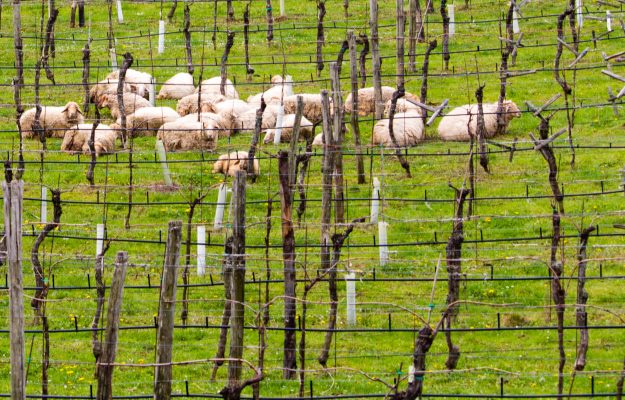No machinery and no herbicides are used, just animals grazing in the vineyards managing and trimming the grass, to improve the healthiness of the soil. It is actually an ancient and proper, as well as not specialized, practice in agriculture, while today it is considered a “niche”. However, it is gradually becoming more and more widespread amongst Italian wineries, from North to South. This practice, which mixes the wisdom of shepherds and farmers, is taking the spotlight and showing all its magnificence; that is, of animals perfectly cleaning the rows of vines by grazing the grass, sustainably, “economically” and silently. Additionally, there is zero waste, it improves and fertilizes the soil while promoting the recovery of nutrients, and maintaining biodiversity. The focus is mainly on sheep, as one of the small, but charming wine companies in the Berici Hills, PuntoZero has adopted (the company is registered with FIVI, the independent winemakers federation), led by Marcella Toffano De’ Besi (the winemaker is Celestino Gaspari, ed.), where the sheep are grazing now. But we can cite many examples, such as the Bepi Boret winery on the Cartizze hill, leader of Prosecco Superiore di Conegliano and Valdobbiadene, or the Tenuta Le Querce, in the Vulture, in Basilicata, or Cottanera sull’Etna, in Sicily. Plus, there is no shortage of different kinds of experiences, such as the “ox project” by Alois Lageder, one of the most famous wineries in Alto Adige, which, among its rows, breeds and lets South Tyrolean cattle graze in its vineyards. There is also the story of geese in the vineyard between rows of Sagrantino di Montefalco at the Di Filippo winery, or in the vineyards of the Sardinian Olianas winery, or even in Chianti Classico, at Casa Emma, just to name a few.
“Grazing in vineyards is a useful practice for both wineries and shepherds, even if there are management differences between organic and biodynamic farms and conventional ones. Clearly, in the former it is simpler, while in the conventional farms the practice can only be adopted during the period when no treatments are being done”, Leonardo Valenti, professor of viticulture at the University of Milan, explained to WineNews. “In the past, it was normal on farms to have poultry animals in the vineyards, such as geese or chickens, the former eating the grass and perfectly trimming it, and the latter eating any insects they could find, and in some cases this still happens. Today things have changed, though, with specialized agriculture, but the practice of grazing vineyards is still very useful. The wineries mainly utilize sheep, because they are animals that respect the plants while grazing, unlike goats, for example, which often also eat bark or roots and can damage the vine. It is an advantageous situation both for the winegrower, who finds a perfectly maintained and clean, from the point of view of grass management, vineyard, and for the shepherd, who finds quality grass to feed his flocks to produce milk and cheese, in the vineyard. Evidently, the animals must be controlled and guided, to prevent them from doing damage, but above all to proceed organically, by plots, without leaving “holes”, as would be done by cutting the grass with machinery. Obviously, it is a practice that can be done when the vegetative cycle of the vine is still dormant, because no treatments are being done in the vineyard, and because there are no buds that otherwise the animals could eat, and the damage would be obvious. So, we are talking about, let’s say, the period from the end of autumn to the end of winter”.
This is a story, like so many in the wine world, which tells how the present and the future of agriculture sometimes recovers or maintains ancient practices.
Copyright © 2000/2025
Contatti: info@winenews.it
Seguici anche su Twitter: @WineNewsIt
Seguici anche su Facebook: @winenewsit
Questo articolo è tratto dall'archivio di WineNews - Tutti i diritti riservati - Copyright © 2000/2025









































































































































































































